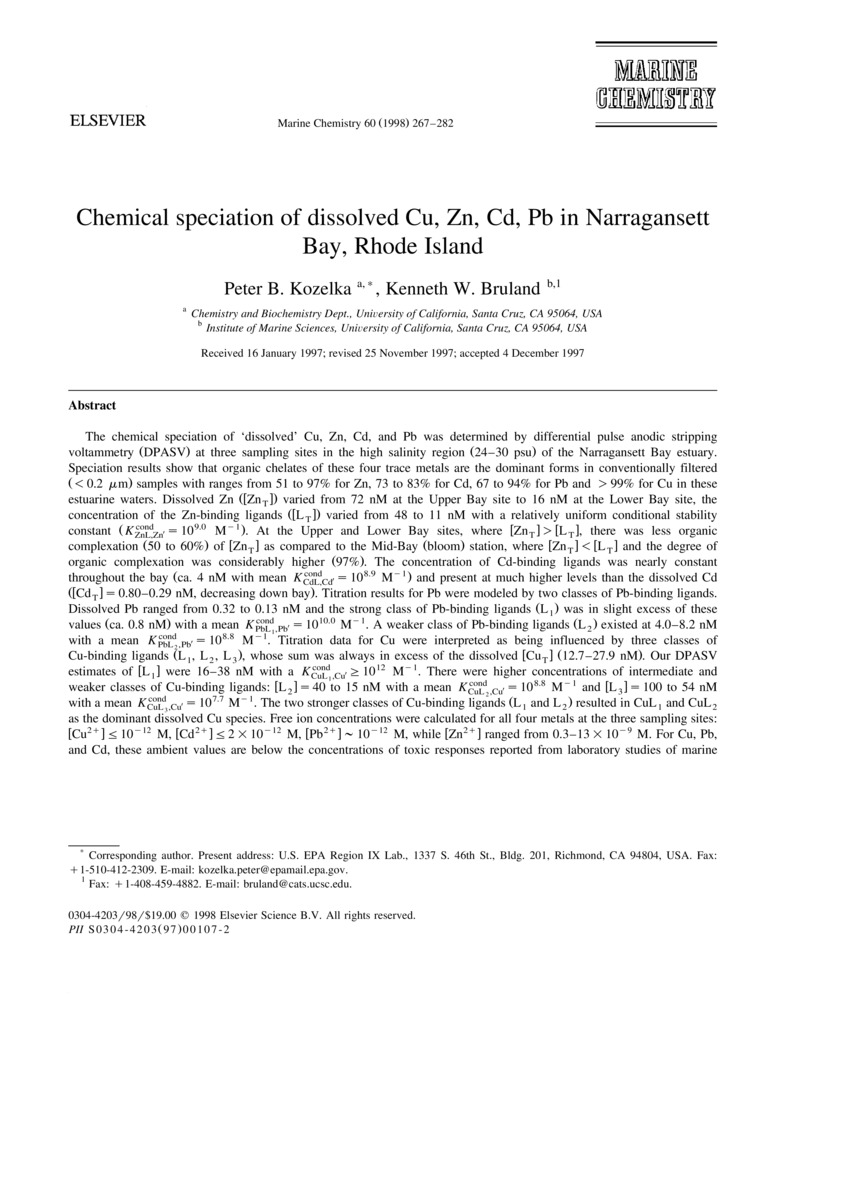Journal Article
AccessChemical Speciation of Dissolved Cu, Zn, Cd, Pb in Narragansett Bay, Rhode Island
The chemical speciation of 'dissolved' Cu, Zn, Cd, and Pb was determined by differential pulse anodic stripping voltammetry (DPASV) at three sampling sites in the high salinity region (24–30 psu) of the Narragansett Bay estuary. Speciation results show that organic chelates of these four trace metals are the dominant forms in conventionally filtered (<0.2 μm) samples with ranges from 51 to 97% for Zn, 73 to 83% for Cd, 67 to 94% for Pb and >99% for Cu in these estuarine waters. Dissolved Zn ([ZnT]) varied from 72 nM at the Upper Bay site to 16 nM at the Lower Bay site, the concentration of the Zn-binding ligands ([LT]) varied from 48 to 11 nM with a relatively uniform conditional stability constant (KZnL,Zn'cond=109.0 M−1). At the Upper and Lower Bay sites, where [ZnT]>[LT], there was less organic complexation (50 to 60%) of [ZnT] as compared to the Mid-Bay (bloom) station, where [ZnT]<[LT] and the degree of organic complexation was considerably higher (97%). The concentration of Cd-binding ligands was nearly constant throughout the bay (ca. 4 nM with mean KCdL,Cd'cond=108.9 M−1) and present at much higher levels than the dissolved Cd ([CdT]=0.80–0.29 nM, decreasing down bay). Titration results for Pb were modeled by two classes of Pb-binding ligands. Dissolved Pb ranged from 0.32 to 0.13 nM and the strong class of Pb-binding ligands (L1) was in slight excess of these values (ca. 0.8 nM) with a mean KcondPbL1,Pb'=1010.0 M−1. A weaker class of Pb-binding ligands (L2) existed at 4.0–8.2 nM with a mean KcondPbL2,Pb'=108.8 M−1. Titration data for Cu were interpreted as being influenced by three classes of Cu-binding ligands (L1, L2, L3), whose sum was always in excess of the dissolved [CuT] (12.7–27.9 nM). Our DPASV estimates of [L1] were 16–38 nM with a KcondCuL1,Cu'≥1012 M−1. There were higher concentrations of intermediate and weaker classes of Cu-binding ligands: [L2]=40 to 15 nM with a mean KcondCuL2,Cu'=108.8 M−1 and [L3]=100 to 54 nM with a mean KcondCuL3,Cu′=107.7 M−1. The two stronger classes of Cu-binding ligands (L1 and L2) resulted in CuL1 and CuL2 as the dominant dissolved Cu species. Free ion concentrations were calculated for all four metals at the three sampling sites: [Cu2+]≤10−12 M, [Cd2+]≤2x10−12 M, [Pb2+]∼10−12 M, while [Zn2+] ranged from 0.3–13x10−9 M. For Cu, Pb, and Cd, these ambient values are below the concentrations of toxic responses reported from laboratory studies of marine microorganisms. At the Upper Bay site, any toxic effect of the elevated free zinc ion concentration is likely to be alleviated by the antagonistic effect of high dissolved Mn.
Publisher - Elsevier
Subjects - Chemical, Copper; Chemical, Zinc; Chemical, Cadmium; Chemical, Lead
Citation: Kozelka PB, Bruland KW. 1998. Chemical Speciation of Dissolved Cu, Zn, Cd, Pb in Narragansett Bay, Rhode Island. Mar. Chem.; 60(3-4):267-282 http://dx.doi.org/10.1016/S0304-4203(97)00107-2
